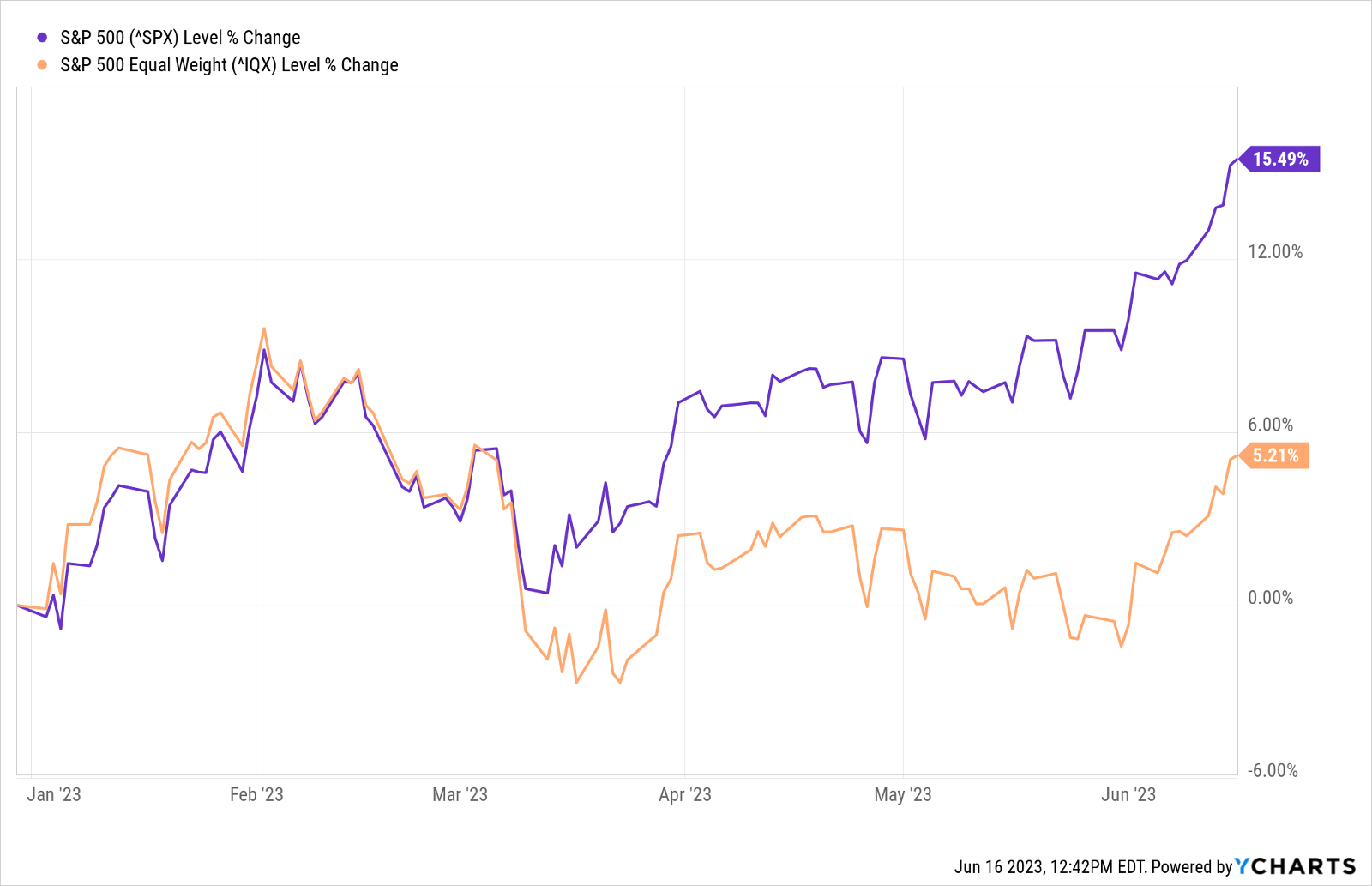What's So Scary About a Mega-Cap Tech Bull Market?
Bears say the market can't keep rallying when only five mega-cap tech stocks are driving returns, but history suggests otherwise.


Have you ever noticed that equity investors can't have nice things? As miserable as we are when stocks are going down, we're even more unhappy when they're going up.
There's an empirical explanation for this psychological phenomenon. It's called loss aversion. Humans are at the mercy of all sorts of cognitive biases, and one of the more perverse ones is that we experience far more pain from losing money than we experience pleasure from winning the exact same sum.
That's why when markets are rising, stocks are said to be climbing a wall of worry. The higher stocks climb, the more investor anxiety mounts. That's loss aversion at work, and it's growing with the market's impressive year-to-date gains. The S&P 500 is up more than 15% on a price basis so far in 2023, which is a terrific first half of any year. We're even closing in on a new bull market.
From just $107.88 $24.99 for Kiplinger Personal Finance
Become a smarter, better informed investor. Subscribe from just $107.88 $24.99, plus get up to 4 Special Issues

Sign up for Kiplinger’s Free Newsletters
Profit and prosper with the best of expert advice on investing, taxes, retirement, personal finance and more - straight to your e-mail.
Profit and prosper with the best of expert advice - straight to your e-mail.
I have no idea where the market is going next, but I do know that pessimism sounds smarter than optimism. Throw in the cognitive bias of loss aversion, and gloomy predictions of correction or crash are irresistible to investors and financial media alike.
This helps explain why bearish calls get so much traction in our collective psyche. We simply can't resist bad news, especially when so many bigtime market pros are making catastrophic calls these days.
The latest such warning came on Friday when Bank of America's Chief Investment Strategist Michael Hartnett told clients that rather than being at the beginning of a "brand new shiny bull market," the S&P 500 is actually enjoying a "big rally before a big collapse."
A day before Hartnett sounded his alarm, JPMorgan strategist Nikolaos Panigirtzoglou advised clients to prepare for a drawdown of as much as 5% in global equities. Meanwhile, no one has been more consistently bearish than Michael Wilson. Morgan Stanley's chief U.S. equity strategist says he expects the S&P 500 to fall by as much as a third over the next three to four months.
The five-stock bull market?
The bears may very well be proven right, but I'd like to add context to one factor that's common to their grave forecasts: the market's lack of breadth.
Doubters of this year's remarkable rally in equities like to say that the market's gains are being driven by "only five stocks." And, yes, there's something to this. The S&P 500 is weighted by market capitalization, meaning that larger stocks have more influence on the direction of the index than smaller ones.
And, yes, when you have multiple stocks with market caps of more than a trillion dollars, well, they really do move the needle when they're all headed in the same direction. The S&P 500's five biggest stocks – Apple (AAPL), Microsoft (MSFT), Amazon.com (AMZN), Nvidia (NVDA) and Google parent Alphabet (GOOGL) – collectively have a weighting of more than 22% in the S&P 500.
Put another way, five of the index's 503 constituents account for more than a fifth of its value.
As we all know, these five mega-caps, which are mostly tech and communications services stocks, are having blowout years. Alphabet, the group's laggard, is up more than 40% through mid-June. The group's leader, Nvidia, has nearly tripled so far in 2023.
Since this is a market-cap weighted index, the big boys are dragging the S&P 500 along with them. Indeed, if you look at an equal-weight version of the S&P 500, which treats every stock the same regardless of market cap, you'll see a very different picture.
Check out the chart below and you'll see that the equal-weight S&P 500 (+5.2% for the year-to-date) is lagging the benchmark market-cap weighted S&P 500 that we all know and love by 10 percentage points.

This freaks some people out because markets in which only a small number of stocks are participating in the upside are supposedly fragile. Markets exhibiting "narrow breadth" don't hold on to gains for very long, the contention goes.
Narrow breadth is kind of normal
There's some evidence for this, but it's hardly a foregone conclusion that narrow breadth will kill the developing bull market before it finds its legs.
For one, much smarter people than me have found that narrow breadth tends to dissipate as a bull market ages. Since a rising tide lifts all boats, the laggards eventually catch up – at least if given enough time.
Secondly, other indicators refute the current claim of a market being driven by just a handful of stocks. Among the more compelling: the S&P 500's advance/decline line – a technical indicator calculating the difference between the number of rising and falling stocks on a daily basis – just hit an all-time high.
But perhaps the biggest reason not to worry too much about narrow breadth is that, historically, at least, this is the market's natural state of being.
The 80-20 Rule – also known as the Pareto Principle – is not a new thing. That's the observation where 20% of the stocks you buy or the movies you produce or the books you publish tend to generate 80% of your returns or revenue.
If anything, when it comes to equities, the Pareto Principle greatly understates this phenomenon. Research by Hendrik Bessembinder, finance professor at the W.P. Carey School of Business at Arizona State University, found that if it weren't for narrow breadth, we wouldn't really have any returns at all.
"When stated in terms of lifetime dollar wealth creation," Bessembinder writes, "the best-performing 4% of listed companies explain the net gain for the entire U.S. stock market since 1926, as other stocks collectively matched Treasury bills."
The bottom line is that, on a long-term basis, a small number of stocks always drive most of the market's returns.
There will always be a surfeit of reasons for investors to fret as stocks climb the usual wall of worry. Eating your kishkas out because 2023 has thus far been the year of mega-cap tech stocks probably isn't one of them.
Profit and prosper with the best of Kiplinger's advice on investing, taxes, retirement, personal finance and much more. Delivered daily. Enter your email in the box and click Sign Me Up.

Dan Burrows is Kiplinger's senior investing writer, having joined the publication full time in 2016.
A long-time financial journalist, Dan is a veteran of MarketWatch, CBS MoneyWatch, SmartMoney, InvestorPlace, DailyFinance and other tier 1 national publications. He has written for The Wall Street Journal, Bloomberg and Consumer Reports and his stories have appeared in the New York Daily News, the San Jose Mercury News and Investor's Business Daily, among many other outlets. As a senior writer at AOL's DailyFinance, Dan reported market news from the floor of the New York Stock Exchange.
Once upon a time – before his days as a financial reporter and assistant financial editor at legendary fashion trade paper Women's Wear Daily – Dan worked for Spy magazine, scribbled away at Time Inc. and contributed to Maxim magazine back when lad mags were a thing. He's also written for Esquire magazine's Dubious Achievements Awards.
In his current role at Kiplinger, Dan writes about markets and macroeconomics.
Dan holds a bachelor's degree from Oberlin College and a master's degree from Columbia University.
Disclosure: Dan does not trade individual stocks or securities. He is eternally long the U.S equity market, primarily through tax-advantaged accounts.
-
 How to Avoid the Financial Quicksand of Early Retirement Losses
How to Avoid the Financial Quicksand of Early Retirement LossesSequence of returns — experiencing losses early on — can quickly deplete your savings, highlighting the need for strategies that prioritize income stability.
-
 How an Elder Law Attorney Can Help Protect Your Aging Parents
How an Elder Law Attorney Can Help Protect Your Aging ParentsIf you are worried about older family members or friends whose financial judgment is raising red flags, help is out there — from an elder law attorney.
-
 Q4 Post-Mortem From an Investment Adviser: Year of Resilience
Q4 Post-Mortem From an Investment Adviser: Year of ResilienceFinancial pro Prem Patel shares his take on how markets performed in the fourth quarter of 2025, with an eye toward what investors should keep in mind for 2026.
-
 'Donroe Doctrine' Pumps Dow 594 Points: Stock Market Today
'Donroe Doctrine' Pumps Dow 594 Points: Stock Market TodayThe S&P 500 rallied but failed to turn the "Santa Claus Rally" indicator positive for 2026.
-
 Stocks Struggle for Gains to Start 2026: Stock Market Today
Stocks Struggle for Gains to Start 2026: Stock Market TodayIt's not quite the end of the world as we know it, but Warren Buffett is no longer the CEO of Berkshire Hathaway.
-
 Stocks End Volatile Year on a Down Note: Stock Market Today
Stocks End Volatile Year on a Down Note: Stock Market TodayAfter nearing bear-market territory in the spring, the main market indexes closed out the year with impressive gains.
-
 Stocks Extend Losing Streak After Fed Minutes: Stock Market Today
Stocks Extend Losing Streak After Fed Minutes: Stock Market TodayThe Santa Claus Rally is officially at risk after the S&P 500's third straight loss.
-
 Santa Claus Rally at Risk as Tech Stocks Slump: Stock Market Today
Santa Claus Rally at Risk as Tech Stocks Slump: Stock Market TodayThe Nasdaq Composite and Dow Jones Industrial Average led today's declines as investors took profits on high-flying tech stocks.
-
 My Top 10 Stock Picks for 2026
My Top 10 Stock Picks for 2026Each year, we ask an expert to pick 10 stocks that have the potential to beat the market over the next 12 months. Here are his choices for 2026.
-
 Gold and Silver Shine as Stocks Chop: Stock Market Today
Gold and Silver Shine as Stocks Chop: Stock Market TodayStocks struggled in Friday's low-volume session, but the losses weren't enough to put the Santa Claus Rally at risk.
-
 The Santa Claus Rally Officially Begins: Stock Market Today
The Santa Claus Rally Officially Begins: Stock Market TodayThe Santa Claus Rally is officially on as of Wednesday's closing bell, and initial returns are positive.